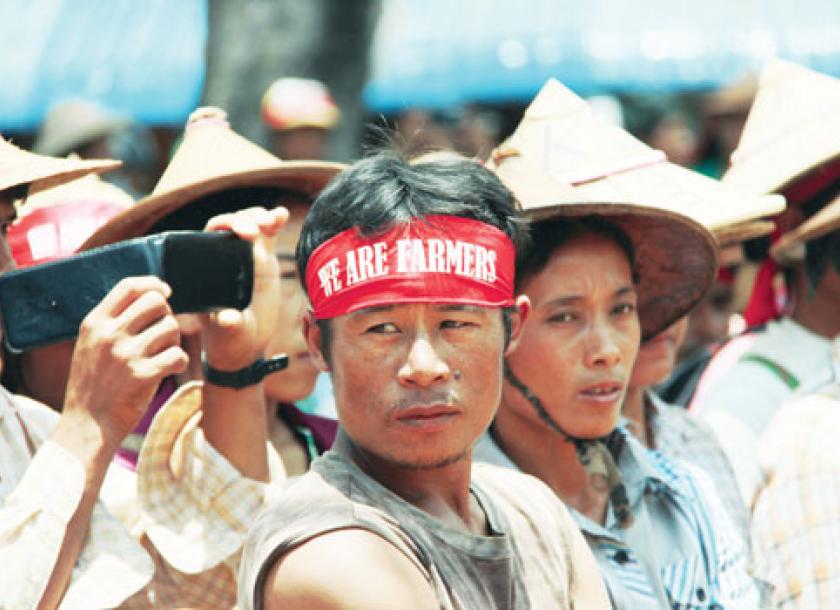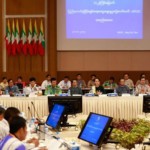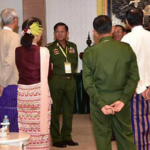By Sai Wansai / Shan Herald Agency for News (S.H.A.N.) | August 2, 2018
On July 17, Human Rights Watch (HRW) called on the government for compensation of illegally confiscated land, and urged to enact laws to protect farmers in its 33-page report.
“Over the past 30 years, Myanmar government and military officials have seized vast swathes of land from farmers while providing them no or inadequate compensation, which denies them livelihoods and erodes access to basic services,” according to the report.
Adding to the hardship of their land being confiscated, “Many farmers have faced criminal prosecution for protesting the lack of redress and refusing to leave or cease work on the land that was taken from them,” emphasized the report.
“Widespread land confiscations across Myanmar have harmed rural communities in profound ways for decades,” said Phil Robertson, deputy Asia director of HRW. “Aung San Suu Kyi’s government should promptly address illegal land confiscations, compensate aggrieved parties, and reform laws to protect people against future abuses.”
Land confiscations have long plagued the rural population of Myanmar since early 1990s under the repressive, successive military regimes. While official statistics confirm that the government took hundreds of thousands of acres, activists believe millions of acres were seized often with little or no compensation for those affected, creating a “profoundly harmful” impact on them.
The seized land was used for military training and exercise grounds, plots for military veterans to farm, and rubber plantations and shrimp farms. Some land was later sold to corporations and businesses, followed by additional sales to other parties, said the report.
Ethnic customary land law and government’s policy
On July 25, VOA reported that the Karen National Union (KNU) issued ownership certificates for some plots of land between Bago Region, Yetarshay Township and Karen State, Thandaung Township. But the Bago Regional government’s Border Security Ministry has protested against it. This clearly shows that the Ethnic Armed Organizations (EAOs) controlled areas make use of their own customary law and don’t follow the law of the central government.
Thus, while decades-long land confiscation policy of the successive military governments still weighs heavily on those affected countrywide, it is crucial to look at the issue from the ethnic customary land law dimension.
According to Myanmar Centre for Responsible Business (MCRB) report of May 24, 2018, the concern for transparency on customary land law and the need to be in tune with the International Covenant on Economic, Social and Cultural Rights (ICESCR) were duly noted as below.
- It will be difficult to obtain clarity over issues like customary tenure by amending existing land laws – as is currently under way in Parliament – rather than first adopting an over-arching Land Rights law as envisaged in the National Land Use Policy.
- Customary land use is currently being interpreted in two different ways: informal use of lowland areas e.g. for pasture; and traditional or customary use in upland areas by ethnic minorities. While the former type is increasingly recognised as a right that needs to be compensated, the government and lawmakers are ducking the issues related to upland customary land use systems, citing the peace process as an excuse.
- The Myanmar Government signed and ratified the International Covenant on Economic, Social and Cultural Rights (ICESCR) in 2017. This means that Myanmar law needs to be aligned with the Covenant and protect ESC rights. Currently a number of Myanmar land laws, and amendments to those laws (e.g. Virgin Vacant and Fallow (VFV) Land Law, draft law to replace the 1894 Land Acquisition Act are not compliant with Myanmar’s ICESCR obligations. Businesses also have a responsibility to respect these rights.
Moreover, “Under section 37 of the Constitution of the Republic of the Union of Myanmar, it is provided that the Union is the ultimate owner of all lands in the Union, shall enact necessary law to supervise extraction and utilization of State-owned natural resources by economic forces; shall permit citizens right of private property, right of inheritance, right of private initiative and patent in accord with the law,” according to the government’s National Land Use Policy of January 2016.
But the ethnic nationalities’ position is contrary to the government’s land use policy.
The excerpts below were taken from a meeting that took place in Nay Pyi Taw, at the National Reconciliation and Peace Centre (NRPC), from May 7-9, 2017, at the “2nd Land and Environmental Sector Negotiation Meeting” in Karen Peace Support Network’s (KPSN) report of July 2018, titled: “ Burma’s Dead-End Peace Negotiation Process: A Case Study of the Land Sector.”
It is said to highlight the land policy positions of the Karen and other ethnic national, which were roundly rejected by the Myanmar Army stating Union government is mandated to manage all issues regarding land use.
- The legal framework of land ownership and management must be decentralized and in line with the traditional customs and culture of the people in the state and shall include land and natural resources under and above the ground.
- Local indigenous people have the right to collectively use and manage their communal land and the land surrounding their villages, such as pasture land, forest, lake, seasonal islands and sacred land.
- Policies and mechanisms must be established to solve the problem of managing transboundary land and natural resources between states and countries.
- States of a Federal Union must have rights to adopt and implement land and environment policies that are suitable to their state.
The Kachin Independence Organization (KIO) also issues individual land use certificates. “We have a different perspective on land ownership,” says a senior KIO official. “In Kachin and Shan states, all the land belongs to the native people who have traditional titles over these. But the Myanmar government thinks this is free and vacant land,” according to Tom Kramer in his article “ Ethnic Conflict and Lands Rights in Myanmar” published in Summer 2015.
Again, basic principles for customary land tenure systems of Shan State was defined by Statement of Customary Land Tenure Workshop, Taunggyi, Shan State, Myanmar 26-27 August 2016, as follows.
- All the land in ethnic regions must belong to the people of these lands as it is their life-blood and their way of life. Local ethnic people must have full entitlement for the management of all land and related resources within their regions with their own customary systems.
- Customary tenure systems include management of community forest, wildlife sanctuary, protected forest, sacred land, cemetery land, shifting cultivation areas, pastoral land, common land and village reserve land including other land and water sources and watershed areas within the village boundary.

Tatmadaw’s land confiscations
While the Shan State’s Land Tenure Workshop did pinpointed the perpetrators as “Local communities in ethnic areas in Shan State are facing land grabbing by various actors: the Myanmar army, the Forest Department, companies, militia groups backed by the Myanmar army, and organizations related to the Government,” available statistics pointed out that the Tatmadaw or Myanmar Army is in fact the main perpetrator.
“The Tatmadaw’s role in land confiscations is increasingly seen as a major problem by the country’s reformers. In May 2013, the Farmland Investigation Commission submitted its first report to Burma’s Union Parliament, choosing to focus on military land confiscations,” according to Global Witness publication of March 2015, titled: “Guns, Cronies and Crops – How Military, Political and Business Cronies Conspired to Grab Land in Myanmar.”
The report revealed that, between late July 2012 and January 2013, the Commission had received 565 complaints alleging that the Tatmadaw had forcibly confiscated 247,077 acres (almost 100,000 hectares) of land. The Commission recommended that land that had not yet been developed by the military be handed back to its original owners or the state. Where the land had already been put to use, the military should pay adequate compensation to affected farmers.
“The centralization of power with the military-state has facilitated widespread dispossession and displacement of the country’s small-holder farmers from their ancestral lands. A 2015 study by the Land In Our Hands network indicates that the Burma Army is the leading entity responsible for land confiscations, accounting for 47.7% of all land confiscations surveyed, while government departments were involved in 18.8%, and companies in 13.9%,” according to the July report of KPSN.
While the HRW said the National League for Democracy (NLD) government’s efforts to effectively address the situation have met with limited success, Myanmar’s military in a bid to polish its image against the accusation, on July 18, said that it has been returning to its rightful owners all unused lands it confiscated for decades from farmers.
However, in June, General Myint Nwe, Myanmar’s deputy defense minister, told lawmakers that the armed forces would not return lands seized from civilians for security or training purposes in conflict-ridden Shan or Rakhine states or pay them compensation.
His comment came in response to questions from legislators about whether the national military planned to return lands seized in Kaykham village, Lashio township, in northern Shan state after villagers lost all the land they had worked on for generations, and whether it would compensate owners for land confiscated by the military to build a new city project in Rakhine’s Ann township, according to the RFA report of July 18.

Perspective
As all could see the confrontation on the issue of land confiscation and land use between the government’s Tatmadaw faction and the EAOs, including the ethnic CSOs, is imminent and the situation is deteriorating.
The EAOs and the ethnic nationalities are for the recognition of their customary land law, which centers on ownership of the people. But the government, including the Myanmar Army, are that the Union is the ultimate owner of all lands in the Union.
With the bulk of the land confiscation being carried out in the ethnic states and the linking of the ethnic nationalities in their call for rights of self-determination to the issue, not to mention their resources-sharing and power-sharing demands, which are part and parcel of the scheme to establish a genuine federal union, only accommodation and redress of land confiscation issue will lead to a conducive peace process atmosphere.
In this respect, a way on how to blend in the two positions, land ownership of people and government’s monopoly claim of the rights to manage the country’s land use, should be seriously considered to be able to complement the ongoing peace process in a positive aspect.
This article originally appeared on S.H.A.N. on August 2, 2018.






